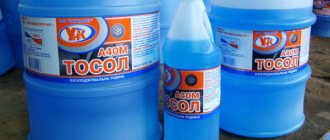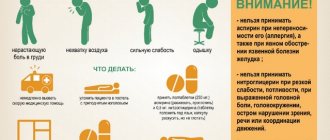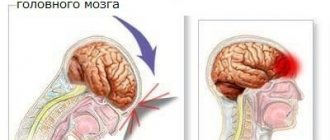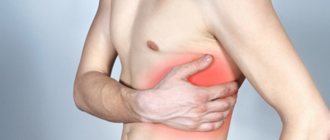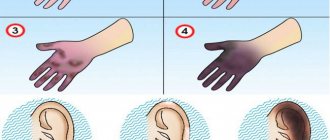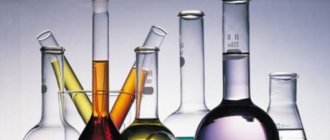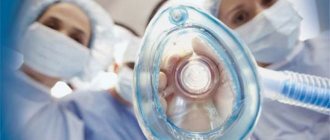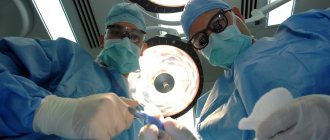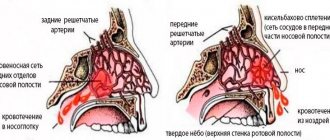First aid for heat and sunstroke
Heat stroke is a violation of the body's thermoregulation as a result of prolonged exposure to high environmental temperatures. Overheating can be caused by hot, windless weather with high levels of air humidity, and active physical work.
Sunstroke is heat stroke caused by direct solar radiation.
The symptoms of both conditions are similar.
- First, fatigue, weakness, headache, dizziness, pain in the legs and back occur, and vomiting may occur.
- Later, tinnitus, shortness of breath appear, heart rate increases, and vision becomes dark.
If help is not provided at this stage, then further overheating leads to rapid damage to the central nervous system, cyanosis of the face occurs, severe shortness of breath, the pulse becomes frequent and weak. Muscle cramps occur, delusions and hallucinations appear, breathing becomes uneven. The victim may lose consciousness at any time.
Unfortunately, a person can rarely objectively assess the changes happening to him. Therefore, it is important to have people nearby who can provide first aid for heatstroke.
If the person near you experiences the above symptoms or becomes unconscious during hot weather:
- It is necessary to move the victim to the shade or a cool room and lay him down with his head raised.
- You need to take off your clothes and loosen your belt.
- Apply a cold compress to your head. Wipe the body with cold water, starting from the heart area, or wrap it in a damp sheet.
- If the person is conscious, give him a drink of cool water. In case of loss of consciousness, induce breathing with ammonia and turn the victim on his side.
- Call an ambulance.
If you transport a patient to a medical facility yourself, make sure that the victim lies down.
Medical assistance is needed in case of severe sunstroke or heatstroke, as doctors will be able to prevent the possibility of heart attack, stroke and other serious consequences of overheating. But it is quite difficult to determine the severity of the victim’s condition based on the symptoms, so call an ambulance in any case.
In order for summer days to bring joy and not create problems, it is necessary to follow preventive measures:
- Don't go outside without a hat.
- Wear light-colored clothing made from natural, breathable fabrics.
- Avoid direct sunlight.
- Limit your intake of fatty, heavy foods and perishable foods (including ice cream). Give preference to cold (but not ice-cold) soups, lean meats, vegetables and fruits.
- Drink plenty of still water or cool green tea.
- Avoid alcohol.
These simple steps will help you avoid not only heat and sunstroke, but also other common summer problems - food poisoning, dehydration and water accidents.
First aid for heat stroke in a child
Heat stroke (hyperthermia) is a life-threatening condition. This phenomenon occurs as a result of severe overheating. Often, body temperature rises due to the fact that the body cannot cool itself, that is, the process of thermoregulation is disrupted.
Children are especially susceptible to heatstroke, since their body is not yet strong enough, many processes in it are still imperfect. It is very easy for babies to be exposed to heat during the hot season, for example, while walking in hot weather, as well as when the body is dehydrated. Many parents make a big mistake by dressing their child warmer than the season or weather conditions require. In addition, sunburn is an additional risk factor for heat stroke. Also, you should not leave a child in a parked car, because in such conditions, damage can occur in just a few minutes, since the temperature rises much faster in transport than on the street.
SYMPTOMS OF HEAT STROKE IN SMALL CHILDREN
The following symptoms will help you determine if your child has heatstroke:
High temperature without sweating;
The skin often turns red, but with severe damage it becomes deathly pale;
Skin is hot to the touch;
Restless behavior, for example, aggressiveness, moodiness;
Headache; Dizziness;
Absent-mindedness and lethargy, for example, the baby does not respond to the parents’ calls, tickling, etc. He may become lethargic as weakness occurs;
Nausea and vomiting;
Breathing is rapid, shallow;
Unconscious state. Parents should pay special attention to the symptoms of dehydration that accompany heatstroke of any severity.
With mild to moderate damage, correctly provided first aid becomes the key to a successful recovery. However, in the case of severe hyperthermia, there is no guarantee that the person will be saved. In more than 30% of cases, death is reported despite radical measures.
SIGNS OF HEAT STROKE AND DEHYDRATION IN A CHILD
Parents should immediately provide first aid to their child if they observe the following symptoms:
Intense thirst;
Sticky saliva, dry mouth;
Minor urination, urine dark yellow or light brown;
When the eyes stop watering, it means dehydration has become moderate; Cold extremities;
Point spasm;
Severe dehydration is indicated by uncontrollable behavior;
Inability to walk or stand;
Weak rapid pulse;
Pupil dilation;
Minor urination for 12 hours or no urination at all;
Fainting.
The severity of symptoms largely depends on the intensity and duration of exposure to heat on the body. Factors such as the presence of diseases, allergies, weather sensitivity, taking medications, and the age of the baby also play an important role.
Step-by-step first aid is as follows:
- Undress the baby and move to a cool place. When the child is outside, it is worth moving him to the shade, although the best option would still be a cool room;
- Before the ambulance arrives, the child’s body must be wiped with a sponge, towel or any suitable cloth soaked in water. You can apply compresses. But the water should not be icy, but simply cool, to avoid vascular collapse.
- Lotions are applied to the following areas and parts of the body: forehead, back of the head, neck, temples, collarbones, inner bend of the elbows, under the knees, calves, groin, sacrum;
- Fanning with objects that imitate a fan;
- You definitely need to talk to your baby so that he feels calmer;
- Drink plenty of small sips. The water should be warm, but not cold, otherwise the child will vomit. You can give a solution of 5% glucose, baking soda or salt. It is worth noting that diet therapy is used for infants. It is recommended to skip one breastfeeding on the first day of illness and reduce the total amount of food by a third. The diet should include products such as kefir, sour mixtures and biological products. In the following days, the amount of food should be gradually increased to normal.
- It is better to lay the patient on his back and raise his head or turn him on his side if vomiting occurs;
- If breathing problems are observed, apply a cotton swab soaked in ammonia to your nose several times;
- Before consulting a doctor, you should not give the victim any antipyretics, as they will not reduce the temperature and may blur the clinical picture;
- If breathing stops, immediately perform artificial respiration and closed heart massage. When the first signs of heat exhaustion appear, but it does not develop into heat stroke, it is recommended to take the patient to a cool place as soon as possible and give him something to drink. It is worth noting that the liquid should not be too sweet or cold, otherwise abdominal muscle spasms will occur. You can bathe your child in a cool bath or shower (water temperature - 18-20 degrees). After this you cannot go outside. If the victim’s condition is not improving, it is better to call emergency help or transport him to a doctor yourself.
- Heatstroke in a child takes a long time to be treated and requires several weeks of rehabilitation. During this period, it is not recommended to go outside, and you must also adhere to bed rest. Parents of young children should be well aware of all the measures described above. First, you need to cool your body
- Secondly, ensure you drink plenty of fluids.
- Thirdly, call emergency help if life-threatening symptoms appear. In most cases, such treatment has a positive effect. In addition, you can cool the body using any available means, but do not use too cold water. If heatstroke occurs while on vacation, you can immerse the victim in a body of water, such as a lake or river. Wiping is performed not only with plain water, but also with a weak vinegar solution. The baby should be given a drink every 20-30 minutes. Instead of water, a solution of Regidron, which can be purchased at a pharmacy, is suitable.
PREVENTION
Every parent should take care of the health of their child. The following tips will help you prevent heat stroke:
1. Do not go outside with your child during the hottest hours - from 11 to 16.
2. Avoid too active games and physical activity at this time;
3. Protect your head from direct sunlight. Not only hats, but also umbrellas are suitable for this;
4. Dress the baby only in clothes made from natural materials, for example, cotton, linen, wool. It is better to give preference to light colors.
5. Also, do not wrap your baby up too much, because heat stroke can occur not only in the summer, but even in winter;
6.Do not go out into the open sun during the period of its highest activity
7.Ensure plenty of fluids. Fruit drinks, kvass, and tea perfectly quench your thirst;
8. Constantly ventilate the premises, open windows. If the house has a fan or air conditioner, use it periodically;
9.Do not overfeed your baby. The above preventive measures do not require special effort, time or money, but they can completely eliminate the risk of heat stroke.
Take care of the health of your children, monitor their well-being and at the first sign of illness, immediately seek help.
Reminder about sun and heat stroke
Summer is the best time to relax and improve your health. In order to enjoy this wonderful time and not harm yourself, you need to remember the rules for preventing heat and sunstroke.
Sunstroke and heatstroke are conditions that occur as a result of overheating of the body. Children, obese people, and patients with cardiovascular and endocrine diseases are especially susceptible to overheating.
Sunstroke
occurs when overheated by direct sunlight, especially the head. The first signs are lethargy, weakness, nausea, headache, dizziness. Subsequently, body temperature rises (up to 38-40°C), vomiting appears, fainting, and convulsions are possible.
Heatstroke
most often occurs in hot, windless weather. People who cannot tolerate heat well or are engaged in heavy physical work are especially susceptible to it. The occurrence of heat stroke is facilitated by dark clothing that does not reflect the sun's rays well, or clothing that does not allow air to pass through and traps body evaporation. Heat stroke can also occur indoors at high temperatures and high humidity.
rules for preventing heat and sunstroke
- on hot days, stay outdoors, preferably until 10–11 o’clock in the afternoon; then it is advisable to stay in the shade;
- go outside only wearing a hat;
- limit physical activity;
- It is advisable to move the main meal to the evening hours, limiting the consumption of fatty and protein foods;
- drink more fluids than usual, excluding drinks with caffeine and a lot of sugar, as they cause dehydration;
- eliminate the consumption of alcoholic beverages;
- take a shower as often as possible;
- reduce the amount of cosmetics, as they interfere with the normal functioning of the skin;
- clothing should be loose, comfortable, preferably made of cotton fabrics;
- do not leave the car in the sun and do not stay in a hot car for more than 10 minutes
First aid for victims of heat or sunstroke:
- If you have signs of heatstroke or sunstroke, call your doctor.
- Before the doctor arrives, immediately eliminate the heat exposure, move the victim to the shade or cool place;
- put him in the shade; if he has a very pale face, apply cold to his head as soon as possible and raise his legs;
- if the victim is conscious, offer him cold water (preferably cold sweet tea, still mineral water, as well as ice cream or ice),
- if the victim has a feeling of lack of air, shortness of breath or chest pain, it is necessary to provide him with a semi-sitting position;
- Apply cold to his head, chest, abdomen, feet and hands (you can use cold water bottles, wet sheets or towels);
- put a separate towel on your face and forehead and change it every 2-3 minutes;
- To stimulate the victim's breathing, pat the face with a towel (handkerchief) soaked in cold water, let him inhale ammonia, oxygen, and rub the body. Before the doctor arrives, give a teaspoon of cordiamine, 1-2 ampoules of a 10% caffeine solution (orally). If breathing is difficult or stops, give artificial respiration.
Attention! If the victim’s face is very red and convulsive twitching is noted, then it is necessary to apply cold to his head as soon as possible, do not raise his legs!
Burns.
They represent damage to the skin and underlying tissues caused by exposure to thermal or chemical factors. It is much less common to have to deal with burns caused by X-rays or exposure to radioactive radiation. There are four degrees of burn: I - with damage to the surface layers of the skin (redness, pain and soreness when touched), II - with the formation of blisters. III and IV - with the development of areas of necrosis (death) of deeper layers, sometimes to the bones. Burns covering an area of 25% of the body surface or more are life-threatening. With extensive third- and fourth-degree burns, burn disease develops (moderate fever, general malaise in mild forms; high temperature, pronounced changes in internal organs in severe forms of the disease).
When providing first aid for flame burns, you must immediately stop exposure to high temperature (throw on some kind of blanket and press it to your body), or, as a last resort, roll on the floor, trying to put out the flame). The burned area is doused with a stream of cold water for 10–15 minutes (you cannot use a fire extinguisher when extinguishing burning clothing). You should not touch the burnt skin with your hands, and you should not try to remove the stuck remains of burnt clothing (carefully cut off only their edges with scissors). In case of extensive, severe burns, the victim, taking precautions and covering the burn wounds with a sterile or at least a clean bandage, or a sheet well ironed with a hot iron, is urgently taken to the hospital, warming him along the way with heating pads and giving him plenty of fluids. Before departure, if possible, cardiovascular and painkillers (amidopyrine, analgin) are administered.
For burns with boiling water or other hot liquids, it is recommended to keep the burned, previously exposed area under running cold water for 15 - 20 minutes or immerse it in cold water, after which it is enough to powder the burned area with starch, lubricate it with some nourishing cream or apply it on it for 5 - 10 minutes, a bandage soaked in vodka and cologne. If blisters appear, apply a sterile bandage to the burned area and consult a doctor. It is strictly forbidden for the victim to open the blisters, which can lead to infection of the burn surface.
For burns with acids and alkalis, the burn surface is washed generously with water, preferably under pressure (for example, under a stream from a water tap), for 10 - 20 minutes in order to remove the chemical substance (especially long-term washing of the affected area is necessary for burns with sulfuric acid, since By treating the skin with a small amount of water, additional heat is released as a result of the interaction of sulfuric acid with water). If concentrated acid or alkali comes into contact with covered areas of the body, immediately and carefully remove clothing soaked in the chemical. In case of acid burns, the chemical agent is neutralized with bandages moistened with a 2–3% solution of baking soda or soapy water; additionally, the burn site is sprinkled with chalk and tooth powder. For alkali burns, use bandages moistened with a solution of boric or citric acid (1/2 teaspoon per glass of water) or 1 - 2% solution of table vinegar, followed by application of a sterile bandage.
In case of burns with quicklime, pieces of lime are removed using a gauze or cotton swab, and then the affected area is washed generously with some oil, but not with water, since heat is released as a result of the interaction of quicklime with water; To neutralize lime, lotions with a 20% sugar solution are also used.
For phosphorus burns, the affected area of the body is immersed in water and unburned pieces of phosphorus are removed under water with tweezers. A lotion of 5% solution of copper sulfate or potassium permanganate is applied to the wound. Ointment dressings are contraindicated!
Prevention of heat and sunstroke in the hot season
A feature of this pathology is its predictability. Of course, it is difficult to predict that a person will experience heatstroke, but it is quite possible to predict an increased risk based on available environmental data. This is why prevention measures come to the fore. The most dangerous time of year for heatstroke is summer. In order to minimize the possibility of overheating, you should follow the rules of behavior during the heat:
- Try not to stay in the open sun for too long, and if you are in it for more than half an hour, cover your head with a Panama hat. The best place for walking on a hot sunny day is in the shade of trees;
- Try not to go outside between 12:00 and 16:00, as the summer heat is at its peak at this time of day;
- Dress in summer in loose-fitting clothes made of light, light-colored fabrics that are highly breathable;
- Maintain drinking regime. Sweating is one of the most important mechanisms of thermoregulation, however, with the release of sweat, the body loses a significant amount of fluid, which must be replenished to prevent dehydration. In summer, an adult needs to drink at least two liters of water per day, and in some situations (extreme heat, physical activity) significantly more. It should be remembered that sweet carbonated drinks, beer, tea, coffee, tonics cannot replace water, since they increase the secretion of fluid - when they are consumed, the body releases more water than it enters. In extreme heat, you can drink slightly salted water - salt promotes fluid retention in the body;
- Reduce the amount of heavy food in your diet, giving preference to light vegetable dishes, fruits and dairy products.
Parents should remember that children have an imperfect thermoregulation mechanism due to their age, so children are much more likely than adults to be at risk of overheating in the hot season, especially given their high physical activity. Therefore, all of the above rules must be applied to them first.
The summer heat is not only an opportunity to spend time in nature, on a body of water with health benefits - in almost any climatic zone of Russia. In addition to the good mood and staying fit from swimming in a pond, the summer heat can be harmful to your health. You can get heatstroke, overheating of the body. The victim may lose consciousness.
Why is summer heat dangerous and how to provide first aid for heatstroke?
If the air temperature warms up above 35°C, then thermoregulation processes in the human body are disrupted - this almost always leads to very unpleasant and undesirable consequences for human health.
Heat exhaustion is one of the types of effects of elevated temperature on the human body.
Symptoms of heat exhaustion include:
- heart rate increases;
- there is dizziness and fogginess of consciousness;
- there is sticky sweat on the body of the victim due to elevated temperature;
- may be observed in the arms and abdominal area.
- Also, with heat exhaustion, vomiting, general weakness (with severe heat shock), and nausea often occur.
How to provide first aid for heat exhaustion?
First, the person should be moved to a shaded area or building where the air temperature is noticeably lower than where the victim suffered heat exhaustion. Next, you should lay the person suffering from heat exhaustion on their back, placing something under their feet to elevate them a little. Give cool water, but not ice!
Heatstroke.
Caused by overheating of the body with insufficient heat transfer, which can be observed, for example, during a long march in close formation in hot weather or during intense muscular work in rooms saturated with vapors at high air temperatures, in thick leather or rubberized, synthetic clothing and insufficient oral intake fluids (sweating decreases, the evaporation of which cools the body). Weakness, headache, dizziness, nausea, often vomiting, noise in the head, drowsiness, yawning, staggering when walking develop; the face becomes red, the body temperature rises, sometimes to very high numbers; breathing is rapid, shallow, sometimes bleeding from the nose. In very severe cases, muscle spasms of the face, limbs, loss of consciousness, coma.
When providing first aid, the victim should be immediately transferred to the shade, to a cool room, placed on his back, with the head of the bed raised (place a roll of rolled-up clothing under his head), and freed from constricting clothing. The body is wiped with cold water or wrapped in a sheet soaked in water at a temperature of 25 - 26 ° C (first wring out the sheet); Cold lotions are placed on the head. If consciousness is preserved, I give cold water to drink and ammonia to inhale to stimulate breathing. In case of breathing disorders or the threat of cardiac arrest, cardiovascular drugs are administered, artificial respiration, and indirect cardiac massage are used. In prevention, the main role is played by eliminating the causes that can cause heat stroke.
Symptoms of Heat Stroke
The signs of heatstroke and sunstroke are generally very similar. Signs of heat stroke include sudden redness and dryness of the skin, shortness of breath, weak, rapid pulse, and general weakness. Dizziness, severe nausea and vomiting are also symptoms of heat stroke. Pain and muscle spasms may occur. In particularly serious cases, symptoms include hallucinations, involuntary urination, convulsions, and loss of consciousness. Do not ignore the obvious signs of heat stroke and you should immediately consult a doctor.
Heatstroke may cause a person to lose consciousness
With a mild degree of sunstroke, the patient also experiences general weakness, headaches and nausea, and an increased pulse rate. The average degree is characterized by a sharp decrease in motor activity, movements are uncertain, the gait is unsteady, the victim feels stunned, and may faint. With severe sunstroke, normal brain function is disrupted and the patient may even fall into a coma. Clonic and tonic convulsions are observed, as well as involuntary urination and hallucinations. Sudden death may occur. Treatment for heat and sunstroke essentially involves lowering the victim’s body temperature and relieving symptoms.
Sunstroke.
It sometimes occurs during prolonged exposure to the rays of the scorching sun.
Headache, nausea, vomiting, dizziness, tinnitus, and unsteady gait develop; body temperatures rise to high levels. The face is sharply red. Skin burns of 1st and 2nd degree are common. First aid is similar to that for heatstroke. For preventive purposes, on hot sunny days you should wear light clothing that should not prevent sweat from evaporating, protect your head with an umbrella, and lightly light-colored headwear and dark glasses. You should not stay or work in the sun for a long time without a break. If a burn develops, lubricate the affected area with Vaseline or vegetable oil. Do not open the blisters, cover them with a dry sterile cloth and immediately contact the nearest medical facility.
Medical assistance for sunstroke and heatstroke
The doctor will determine whether the assistance provided for sunstroke or heat stroke was able to neutralize the damaging effects of hyperthermia (this is quite possible with mild overheating), or whether the condition still remains dangerous and the patient needs to be treated in a hospital.
To prevent cardiac, respiratory failure and cerebral edema, doctors can take the following actions:
- infusion of large volumes of glucose-saline solutions, taking into account electrolyte disturbances (the level of potassium, sodium, calcium in the body is controlled),
- administration of drugs that improve cardiac function,
- prescribing, if necessary, anticonvulsants (phenobarbital),
- use of antipyretics (paracetamol, ibuprofen, analgin),
- a lytic mixture may be prescribed (aminazine, suprastin, promedol, novocaine),
- inhalation of oxygen,
- according to indications - artificial ventilation.
If help comes on time, serious complications can be avoided. However, disruption of microcirculation and damage to nerve cells during the development of heat stroke leave traces in the form of asthenic syndrome and vegetative-vascular dystonia. At least for several months, special care is needed, since immunity to heat stroke does not arise; on the contrary, a predisposition to its recurrence appears rather.
First aid measures for heat stroke
It is not difficult to discover that a person needs first aid for heatstroke. Without going into details, measures should be taken in all cases where there is reason to believe that acute, i.e. sudden onset, deterioration of the condition is associated with overheating. In such a situation you should:
- Transfer (move) the victim to a cooler place, for example, into an air-conditioned room or at least into the shade;
- Get rid of excess clothing, loosen pressing parts of clothing, ensuring an influx of fresh air;
- If a person is conscious, give him cool water, as well as coffee or tea, which have a tonic effect on blood vessels, thereby stimulating cardiovascular activity. However, it should be kept in mind that coffee or tea is not a replacement for water, because may increase dehydration. They should be offered not instead of water, but together with water;
- The victim should be laid down with his legs slightly elevated;
- Apply cold compresses or pour cool water on the forehead, heart area, bends of the arms and legs (elbows, knees, armpits).
With a mild form of heatstroke, these measures are enough for improvement to occur and body functions to be restored. Usually the victim feels much better within 10-15 minutes.
With heatstroke of moderate severity, improvement occurs after about 30-40 minutes, however, signs of malaise, such as weakness and headache, can persist for quite a long time - up to a day.
If after first aid the expected improvement does not occur, you should seek medical help.
First aid for severe heatstroke should be provided in the same way, but you should immediately call an ambulance, since there is a high risk of disruption of the vital functions of the body. While waiting for the ambulance to arrive, you should be prepared to carry out resuscitation measures in case of cardiac arrest.

